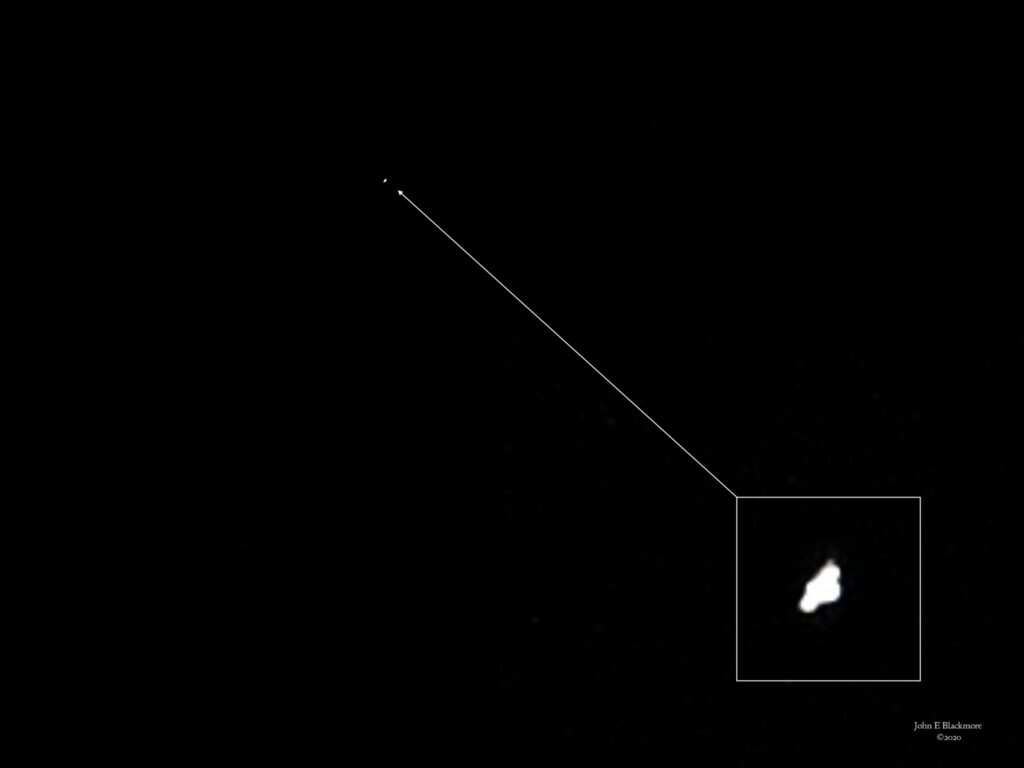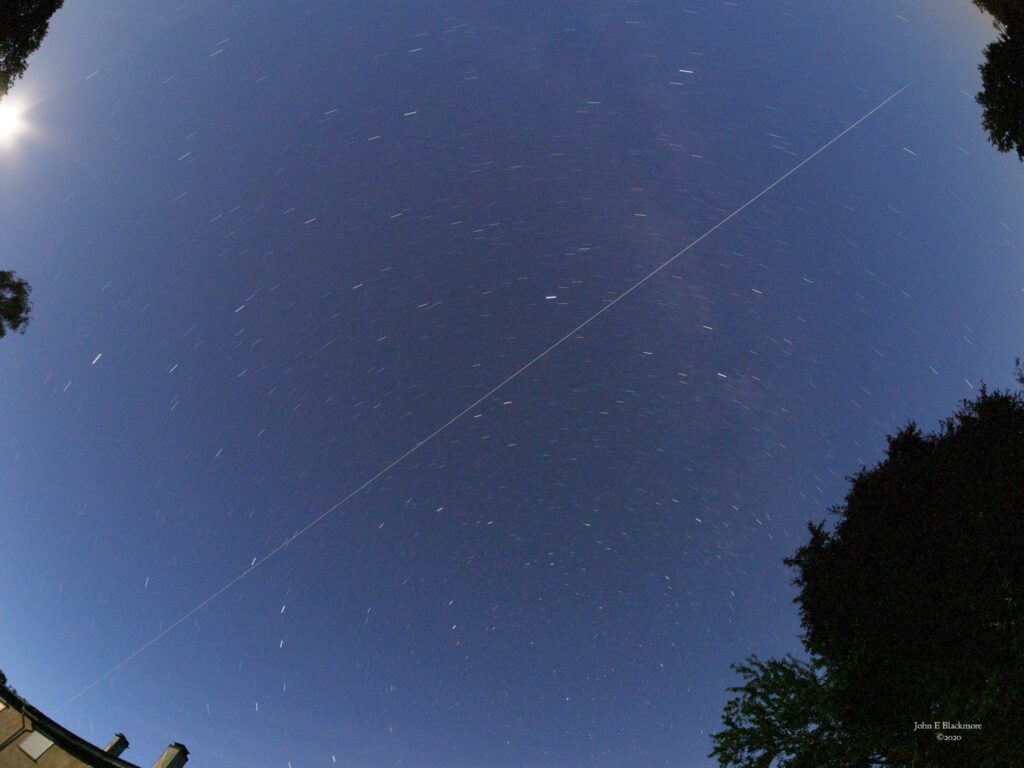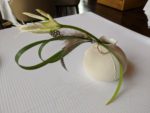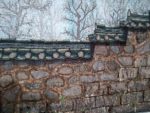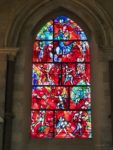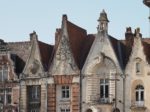To download a printable PDF version
click on this link E2E2019no5.pdf (four A4 pages)
there are various links in the text
A festive first for Entre-deux-Eaux: the commune will be awarding a prize this Christmas for the best decorated property. As we drove through the village today (7th December) there were few signs of anyone having accepted the challenge, apart from the Salle Polyvalente and the village shop. It is possible that people are waiting until after the traditional visit of St Nicholas this evening in Saint Dié or tomorrow afternoon in E2E before turning to the more recent and tackier idea of Father Christmas, reindeer, tinsel and lights.
We were setting out for Barr Christmas market, one of Helen’s favourites, over the hills in Alsace. The week has been sunny, cold and frosty until today when it changed to damp and low cloud. So, as we crossed the Col d’Urbeis, which we had once explored looking for traces of the old German First World War supply railways, there was no snow remaining. The forests below were still an attractive mix of dark conifers with the bare reddish branches of the deciduous trees and the ground cover of copper leaves. Further on we braked on a sharp, blind, bend to avoid the parked cars of people buying their Christmas trees from a popular plantation. And as we descended further to the Rhine plain the slopes were covered with the black pruned stumps of the vineyards. In Barr, the Saturday morning street market with its vegetable, cheese and charcuterie stalls was doing a brisker trade than the indoor Christmas markets.
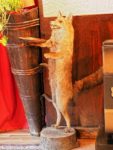
mangy fox
And when we fancied a coffee and pushed our way through the red velvet curtains warding off draughts from the door of a crowded bar, the two older ladies serving wine, beer and coffee sounded harassed. The ambiance was traditional Alsatian with red-and-white tablecloths and dark beams. Close to our big table which we shared with some card players, stood a mangy stuffed fox holding a tray; but it had been pushed against the wall. and was not serving food to the noisy room beyond. Alas, the food and mulled wine stalls outside the Christmas market were not doing a similarly brisk trade; inside were craft stalls – ceramics, glass, fabric, wood tree decorations – and one had a not-very-festive placard announcing Liberté, Fraternité et choucroute (the local pickled cabbage served with with smoked pork).

Christmas bear
As we drove back, the roadside outside Sainte-Marie-aux-Mines was adorned with teddy bears constructed from huge rolls of hay bales and all its shop windows were decorated with furry teddies of all sizes. Perhaps E2E should announce a bear theme for its decorations?
We had hoped to have lunch at the Frankenbourg restaurant after the market, but like several other restaurants this week, it was fully booked. Is this because of the festive pre-Christmas menus or because a lot of public service employees like civil servants, teachers and train drivers have had time for leisurely restaurant meals while on strike against Macron’s proposed pension reforms (I mean, who would actually choose to retire later than they used to because of well-meaning rationalisation attempts?)
During the gloom of November, we have been treating ourselves to lunch out once a week, thanks to a significant refund of our Contribution Sociale Généralisée (CSG) and Remboursement de la Dette Sociale (CRDS) payments. In 2015 the European Court had decided that those pensioners whose health service charges were paid for by another country did not have to pay the CSG and CRDS. France changed the law in 2016 to try to re-impose the charges by moving them to a different fund where the benefits were non-contributory. But a French court overturned that in 2018, so John put in a pre-emptive retrospective claim for the three years. The government appealed again but that was finally overturned in July 2019. But the system grinds slowly so it was November by the time we received the refunds, with their not inconsiderable interest.
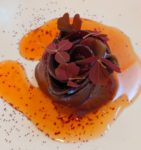
tuna and beetroot strips with hibiscus
The weekly treats started a few days after our return from Letchworth on October 31st (no longer Brexit-at-all-costs day), with a dash to our favourite Restaurant l’Imprimerie in the book village before they closed for their major remodelling and installation of an open wood-fired grill. Chef’s inventiveness that day included the unforgettable combinations of tuna, beetroot and hibiscus in the shape of a crimson rose and of creamy scallops, sliced pig trotter and Jerusalem artichoke. The week after, we went back to In Extremis at the foot of the cathedral in Epinal.
 The following week, after most of that week’s snow had melted, we drove over the hills to Kaysersberg, where the Restaurant l’Alchemille had really gone to town on their Christmas decorations, with a herd of life-sized reindeer, a boar, a grizzly bear, some unconvincing foxes and assorted owls and squirrels crowded round the Christmas trees in the small herb garden in front of the entrance. Entre-deux-Eaux take note!
The following week, after most of that week’s snow had melted, we drove over the hills to Kaysersberg, where the Restaurant l’Alchemille had really gone to town on their Christmas decorations, with a herd of life-sized reindeer, a boar, a grizzly bear, some unconvincing foxes and assorted owls and squirrels crowded round the Christmas trees in the small herb garden in front of the entrance. Entre-deux-Eaux take note!
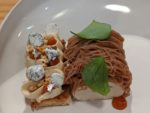
a.k.a. Dougal
One of the desserts we immediately christened “Dougal” as the chocolate strands on the creamy roll looked remarkably like the Magic Roundabout character (although perhaps we should have called it “Pollux”, which was Dougal’s name in the original French Le Manège enchanté). And last week we finally returned to the Ducs de Lorraine in Epinal, for the first time since 2013, now that the rude, brusque Madame, who had separated from the older of the two chefs, and that chef had left. But alas, with aforesaid chef having set up elsewhere, the food was no longer as tasty or well-presented, the amazing dessert trolley much reduced, and the staff equally abrupt (it is hardly the customer’s fault if the waiter brings tea instead of coffee and if he fails to press the right buttons on their credit card machine). We look forward to the re-opening of the friendly l‘Imprimerie!
Cultural events have not loomed as large as gastronomic ones. In fact our last dose of culture was probably during our return journey from the UK. As we now often do, when driving back in winter, we stopped overnight in northern France before it got dark. We went into Cambrai for the first time and walked round the streets near the main square and its dominating Hotel de Ville, including the Tourist Office where we picked up some excellent leaflets. It was so cold, we didn’t linger too long, but drove a few miles further south to the accommodation John had booked. Our usual overnight stops are at a convenient Première Classe or Ibis hotel in an out-of-town commercial area, but John had found a farmhouse chambre d’hôte which had a spacious studio room with cooking facilities. It turned out to be a remote, imposing farmhouse with substantial outbuildings round a courtyard. It looked old, and our hostess told us it had once been a coaching stop as well as farm, but suffered significantly during the First World War and was rebuilt after. She showed us photos of her grandfather there as a child, and her grandmother working as a young woman in the fields, and she also pressed a bulging folder into our hands to read. It turned out that her English guests were usually there to see the war graves of their ancestors in one of the many Commonwealth War Graves cemeteries. She and her husband have helped them and also collected their stories in the folder. So that provided interesting reading that evening in our studio in the outbuildings, along with the Tourist Office leaflets. The thought of a cold, 10km drive in a damp and pitch dark night back to Cambrai for a meal didn’t appeal once we were in our well-heated room so John reheated the vegetables-in-cheese sauce he’d made the night before as a possible standby.
After perusing the leaflets, we decided not to go back into Cambrai the next morning either. Fortified by Madame’s filling breakfast (which was much better than that provided by our usual cheap hotels), we drove cross-country to the departmental Matisse museum, which is based on a collection that Matisse had donated to his home town of Le Cateau-Cambrésis. We suspected that we might not see all his paintings as a special exhibition was opening in a couple of days and the paintings were indeed still being moved or on the wall but shrouded; however it was still worthwhile.
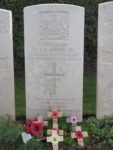
Wilfred Owen’s grave
It is now housed in the former bishop’s palace, along with relevant donations by his publisher (Teriade) and the paintings of another local artist, Auguste Herbin (who we’d never heard of). After a coffee over the road (inevitably the Restaurant du musée Matisse), we drove on to the small village of Ors nearby, where Wilfred Owen is buried in a small military section of the communal cemetery. The revamped forester’s house from which he wrote his last letter home was not open till later in the afternoon, so we went directly to his grave. Apparently the French had not known until quite recently that he was famous as a poet back in the UK.
Helen resumed her various club activities, though they hardly count as cultural. The E2E oldies had their November games, cake and champagne session. Now that the original older members have become housebound or died there is less uninterrupted gossip, and the club is also popular with younger retired people from surrounding villages who enjoy playing cards and have started a craft table as well. It was then Helen’s turn to lead and provide refreshments for the brain exercise group, which she rather dreaded. But the unfamiliar Battleship grids and some Eysenk (remember him?) IQ questions (diagrammatic ones – missing numbers, next-in-sequence etc.) kept everyone fully occupied and John had kindly baked some parkin to revive everyone at the end. The following session, that week’s leader started with a dictation, using a poem with each line containing a second person singular imperative – not something John and I practice all these years since our school French lessons, but it was interesting that most of the group also struggled with the correct written French endings! Scrabble was positively relaxing by comparison.
It is just as well that we had not planned to drive to Letchworth this weekend, with long delays at Calais on this side due to customs staff being on strike as part of the pension protests and with the M25 on that side blocked by the crane accident. John is keeping the car topped up with petrol as there are shortages due to blockades by protesters of some western fuel depots and those might spread across the country. But we hope to travel over next weekend (14/15 December) without encountering too many obstacles and delays for Christmas and New Year. Who will be in charge of the UK by then?
